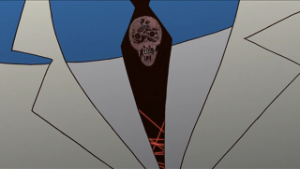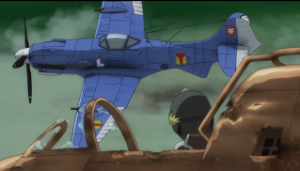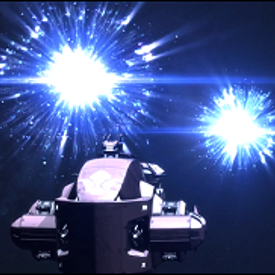 Nobunagun #8: After a brief interlude in Shipper Dream Land, it’s off to Costa Rica to fight the EIOs’ answer to Cthulhu. Shio is getting better control of Nobunaga’s attempts to surface, and she’s able to save the day again while more or less remaining herself this time. At the end of the fight, though, Dogoo seems to abandon her to face the invaders alone…
Nobunagun #8: After a brief interlude in Shipper Dream Land, it’s off to Costa Rica to fight the EIOs’ answer to Cthulhu. Shio is getting better control of Nobunaga’s attempts to surface, and she’s able to save the day again while more or less remaining herself this time. At the end of the fight, though, Dogoo seems to abandon her to face the invaders alone…
This looks like a setup for taking the next step in exploring how the EIOs can interact with human minds. It’ll be interesting to see if Shio winds up in a mind-meld with them, or if they can sense Nobunaga as well.
For the amusement of MST3K fans, we not only have the Clayton Forrester this time, but the movie the preview talks about is Gamera vs. Guiron, an early recipient of the MST3K treatment.
 Kill la Kill #19: With a month going by, it’s time for some exposition! Ragyō spells out for us how this all works: only rebellious teenagers could possibly have fought the Life Fibers, because at 20 years old (the age at which one becomes a full adult in Japanese society) people become habituated to clothes. After that, they’re easy prey to be sucked into a nice suit and lose all their individuality or motivation.
Kill la Kill #19: With a month going by, it’s time for some exposition! Ragyō spells out for us how this all works: only rebellious teenagers could possibly have fought the Life Fibers, because at 20 years old (the age at which one becomes a full adult in Japanese society) people become habituated to clothes. After that, they’re easy prey to be sucked into a nice suit and lose all their individuality or motivation.
What’s to become of Senketsu? I wouldn’t be surprised if Mako tries him on until Ryūko comes to her senses. In fact, the way this show’s been going, I wouldn’t be surprised if the entire Mankanshoku family takes turns making fools of themselves trying to be his host.
 Hozuki no Reitetsu #7: Important tip for Australians: watch out for Japanese tourists in voluminous hats.
Hozuki no Reitetsu #7: Important tip for Australians: watch out for Japanese tourists in voluminous hats.
The Jōhari mirror (no relation to the Johari window from psychology) is the Japanese version of the “karma mirror” that turns up in one form or another in many different Buddhist beliefs. The location and timing vary, but the general idea is that the dead soul presents itself to one of the lords of the underworld (in the Japanese version, Enma is one of ten kings who oversee it) and important events from the person’s most recent life are show there.
 The Pilot’s Love Song #8: With the fight for Isla in full swing and the veteran pilots not yet back, the trainees take heavy casualties—though if you check the opening sequence again to remind yourself just how many named characters there are in this show, the cast really hasn’t been thinned much. Nevertheless, it would be wrong to react to these tragic events by celebrating the fact that, as established by dialogue before Wulf was killed, the show cannot waste another whole episode with the students running a restaurant. Very, very… oh, I’ll admit it, I’m smiling.
The Pilot’s Love Song #8: With the fight for Isla in full swing and the veteran pilots not yet back, the trainees take heavy casualties—though if you check the opening sequence again to remind yourself just how many named characters there are in this show, the cast really hasn’t been thinned much. Nevertheless, it would be wrong to react to these tragic events by celebrating the fact that, as established by dialogue before Wulf was killed, the show cannot waste another whole episode with the students running a restaurant. Very, very… oh, I’ll admit it, I’m smiling.
According to my in-house military aviation expert, the new fighter plane here is the love child of a Spitfire and something in the Yakovlev line, except for those extra little fins near the base of the tail, which are used on seaplanes to counteract the destabilizing effect of the pontoons. On a fighter with no pontoons they would just serve to make it less maneuverable.
But never mind that, because the big deal for fans of the previously adapted The Princess and the Pilot is that Isla’s mysterious new ally comes from Levamme, where that story takes place. And the title princess was named Fana, so we perhaps have a direct connection between the two stories.
At any rate, the idea of figuring out the world and the business of the seeds of Saint Aldista sounds promising.
Whoa, what happened to Samurai Flamenco? It’s on a brief hiatus for the Olympics and will be back next week.










